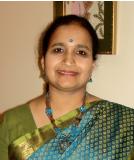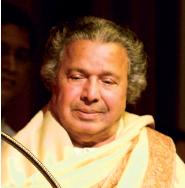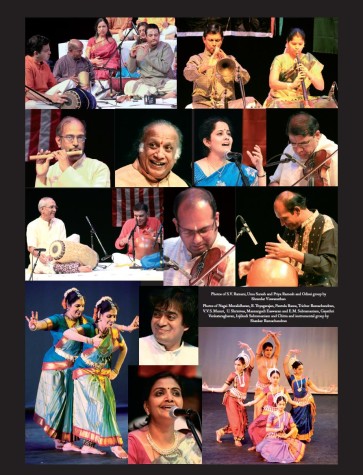An Annual Festival to Remember
Music and Dance at San Diego
Shankar Ramachandran
Combine bright San Diego weather, a vibrant Indian community, and a dedicated board committed to promoting Indian classical music and you get the third annual Spring Music Festival at IFAASD. During its course, more than forty artists perform more than a dozen music and dance concerts. A hundred and fifty local Carnatic music students share their song. Several thousand meals are cooked and served by the local community. San Diego has hosted another music and dance festival that will leave seeds of a cultural memory in the minds, hearts and brains of all who attend and participate. Pride and joy are visible everywhere.
Following mangala isai by Injikkudi Subramaniam and party, the kuthu vilakku is lit. Revathi Subramanian, music teacher and IFAASD board member, sings a GNB song in invocation. Then it is time for the inaugural concert. Some 300 listeners are treated to an excellent recital by the San Diego sitar virtuoso Kartik Seshadri, accompanied by Arup Chattopadhyay on the tabla. Kartik presents Hamsadhwani and Simhendramadhyamam with perfect sruti alignment and poise. “There are stylistic differences between Carnatic music and Hindustani music”, he explains in a brief introduction, “but the divisions are not as clear as sometimes we think they are.”
A student of Pandit Ravi Shankar, an accomplished artist and teacher, head of the Indian Classical Music Program at UCSD, Kartik Seshadri sets a distinctive tone for the festival with his concert. After playing his own composition – a bandish in Simhendramadhyamam – Kartik concludes the concert with a soulful rendering of raga Pahadi Jhinjhoti. Guests sample the home-made Hyderabadi dinner and garam chai in the tranquil architectural outdoor setting of the auditorium at the world renowned Academy of the Neurosciences.
The Board members of the Indian Fine Arts Association are a diverse group marked by the energy and drive to make this infant festival, now in its third year, more than successful. They seem to share a collective vision to make this a festival of world renown while serving the San Diego Indian community. Their names are a who’s who of the Indian community in San Diego County. Headed by President Raj Sundaresan and Secretary Dr. Sekar Viswanathan, the board includes Dr. C.M. Venkatachalam, Meera Venkatesh, Revathi Subramanian, Dr. Vachaspathi Palakodeti, Lakshminarayana Peesapati, Divya Devaguptapu, Dr. Yenamandra S. Rao and Srinivasan Prabha. They worked tirelessly every day to make sure that all the multiple logistics were covered, helped by scores of enthusiastic volunteers. IFAASD was a sleepy little fine arts association until they teamed up with the Cleveland Tyagaraja Aradhana each year. Working closely with CTA, V.V. Sundaram and Cleveland Balu, (San Diego Balu to the locals here), they had the idea of bringing a group of the artists headed for Cleveland to San Diego a week earlier.
“I give them the list of all the artists coming to Cleveland,” said Sundaram. “They make their choices from that.” He chats with me as we watch the mike system being adjusted for the over fifty strong ensemble of students of Dr. C.M. Venkatachalam. Sundaram says to me that it is all about the children. “If, as P.S. Narayanasawamy said,” he adds, “even half a dozen of these youngsters come up in the Carnatic music world, it will have been worth it.” Each year he is responsible for bringing to Cleveland and presenting to North American audiences, the young voices of Carnatic music as well as the seniors. Without him few in North America would know names like Vairamangalam Lakshminarayana, Parassala Ponnammal, and Kalpagam Swaminathan. Young musicians like Amritha Murali and Nisha Rajagopal are seen and heard in North America each year. Mridanga vidwans, tavil vidwans, instrumentalists, accompanists and lead artists all flock together for almost 15 days at Cleveland each year.
Friday evening’s programme is at the Jewish Cultural Center in La Jolla. Guests enjoy a “Tirupati” dinner sold by volunteers for a nominal $5. The food is home cooked by volunteers.
Another thing that makes a big difference is the presence of two dynamic music teachers on the IFAASD board. Both Dr. Venkatachalam and Revathi Subramanian are passionate about Carnatic music and having every one of their students attend kutcheri-s and participate in the festival. Their presence on the board and the unflagging canvassing by them and several other board members have helped swell the membership ranks to some 200 families.
Secretary and President are everywhere and talking to board members and volunteers by phone into the wee hours. No detail is too insignificant. They also host artists and get to the venue at the crack of dawn. On Saturday, Dr. Venkatachalam gets there at 6:30 am before his students so he can attend to the mike set-up for the participants. I see him leave only after the last event of the day. After the weeks and months of training and practice, the tireless teaching, the endless ferrying by parents, the moment of intense anticipation will soon be upon them.
But first, the ensemble of Friday evening, a brainchild of Sashikiran. A group of instrumentalists present an innovative programme starting with a mallari and a few kriti-s followed by the Bhairavi swarajati.
The programme also includes a ‘swara kriti’ in raga-s like Begada, Anandabhairavi and Nayaki. Billed as a “Carnatic Ensemble” with Sashikiran doing some konnakol, the instrumentalists including Guruvayur Dorai, Nagai Muralidharan, R. Thyagarajan, E.M. Subramaniam and Ganesh, provide an interesting presentation of items. The “English Note” composition popularised by Madurai Mani Iyer, followed by the Dhanasree tillana by Swati Tirunal, rounds off the concert.
The main event of Saturday is the early morning group singing by the children. Over fifty of Venkatachalam’s students assemble on the stage. They range in age from seven to forty and above. The Garland of Raga-s begins with Ganesa Pancharatnam. The sound is sweet; the group is well rehearsed and sings as one choir.
Raga-s follow one another in swift succession. The raga transitions are deft. Venkatachalam, music teacher, enthusiast, connoisseur, student of the late Chembai, sits on the floor in front of the stage and keeps tala for the group and “conducts” them with hand gestures. His students present eight ragamalika compositions. Modelled on the ‘Sustaining Sampradaya’ programme first presented at the Cleveland Aradhana a couple of years ago, the group format is both practical and effective. A “swaramalika” composed by Dr. Venkatachalam is followed by a Lalgudi jatiswaram and a padavarnam, both taken from the opera, Jaya Jaya Devi. The programme is a well thought out intertwining of the familiar and the unusual. Arabhimaanam, is followed by Ananda nilaya by ‘Chitravina’ Ravikiran. Sonnadai seithida follows in recognition of GNB who arranged the music. The programme concludes with Purandaradasa’s Ksheerabdhi kannike. Sensitive flute and mridanga accompaniment provided by local artists Radhakrishnan Ramachandran and Kalyan Vaidyanathan makes for a rich listening experience. Cleveland Balu joins them with the khanjira.
The next group is of younger children, the students of Revathi Subramanian. Some 35 of them sing in two sections, presenting a selection of kriti-s to celebrate the genius of Muthuswami Dikshitar. They begin with a delightful rendition by 4-6 year-old children of the group. They sing Dikshitar’s nottu swara kriti-s. Beginning with Sakti sahita Ganapatim, several of these distinctive kriti-s are belted out with robust voices in an unabashed manner unique to the very young.
Their practiced ease was evident as they sing in two octaves. The children are visibly enjoying themselves and singing with pleasure. The next set of youngsters sing Mahaganapatim, Anandamritakarshini, Sreelakshmi varaham, Sree Saraswati and Sivakameswarim. None of them uses notes or any written references. Finally Revathi invites everyone in the auditorium to join in to sing Gurumurtey. Again, the accompanists Radhakrishnan Ramachandran, Raamkumar Balamurti (mridanga) and Cleveland Balu add richness to the group singing. The youngsters are a big reason this festival is held. Will these seeds planted in them during this process, the learning and the exposure, stay with them and return in adulthood as they try to pass on these cultural memories to their children? This is the ardent hope of their parents, their teachers and all those who work so diligently to make this festival possible.
The time for Mysore breakfast with coffee melds into the Tanjavur lunch. Nagaswaram by Injikudi Subramaniam and party follows in the auditorium to an abbreviated audience of about 100 listeners. The delay from the morning eats into the time allotted for this concert. This is the first time since their recent marriage that Subramaniam and his wife Chitra are giving a concert together. A Dhenuka alapana followed by Teliyaleru rama and Nagumomu are notable as is the spirited tani avartanam by the two tavil vidwans S.M. Babu and S.G Abhiramasundaram. Subramaniam then plays an unhurried alapana in the Raga Desh. The slow and majestic cadences of the woodwind echo through the hall, and Tanjavur Sankara Iyer’s composition Rama namame tudi maname follows. Manasi Prasad’s concert titled “Seenappa Nayaka to Purandaradasa”, a thematic journey of the life of Purandaradasa, is a hit with the audience. The Kambhoji and Kalyani alapana-s are both powerful and evocative. She concludes her programme with the popular Jagadoddarana. She is ably supported by V.V.S. Murari (violin), R. Thyagarajan (flute), K. Sivakumar (mridanga) and Cleveland Balu (khanjira).
There are a number of talented artists who make San Diego their home and IFAASD is smart to take advantage of their presence in the community to enrich the festival offering and participation. Local artists also mean more local families in attendance.
Besides Kartik Seshadri, Radhakrishnan Ramachandran, Kalyan Vaidyanathan, Raamkumar Balamurthi, Shoba Sharma, and Divya Devaguptapu, a number of musicians and dancers enrich the local community. Two such dancers were featured in the festival this year.
Uma Suresh, a disciple of Vazhuvoor Ramiah Pillai among others, is a talented dancer, choreographer and teacher. She and her daughter Priya Ramesh present a short Bharatanatyam programme starting with a pushpanjali and including a javali and a tillana. The main piece is Kamalajasya, the Dasavataram composition of Swati Tirunal, choreographed by Uma Suresh. Each avatara is brought to life on stage with dramatic effect. Mother and daughter cover the stage with practised ease.
On the last afternoon, Odissi Fantasy Again is presented by local artists. The popular Patnaik sisters along with Guru Yudhister Naik and their student S. Gollamudi put on quite a spectacle. A small Jagannath idol placed by the lamp on the stage adds a thoughtful touch. Tasteful costumes, graceful movements and excellent recorded music (Charukesi, Mohanam, Desh, Sankarabharanam, Sindhubhairavi) made this programme a hit with the audience.
The brief felicitation ceremony on Saturday includes a violin rendering of the national anthems of India and the United States by a group of youngsters from the local Suzuki school. Several of the young violinists had also participated in the morning group singing.
IFAASD also honours individuals for their contribution to the arts. This year’s honourees include C.K. Prahalad – Vignana Siromani, Cleveland Balasubramaniam – Sangeeta Seva Mani, Katherine and Kunhiraman – Natya Acharya and Padma Kutty – Sangeeta Acharya. Sadly Prahalad is now no more.
The final event is an energetic concert by Mandolin U. Shrinivas and U. Rajesh.
The hall is packed with over 500 attendees. A Carnaticrock thriller from the beginning, the concert starts with a Lalgudi varnam in Charukesi followed by a Hamsadhwani kriti, Endaro mahanubhavulu, Sree Rama padama and Garudagamana samayamide, are all played at a breathtaking tempo and lead up to a well deserved intermission. The appreciative audience applauds every flourish. Veteran M. Swaminathan on the mridanga shows that he can keep up. He and S.V. Ramani on the ghatam match every flourish with a fusillade of their own.
The schedule on the final day of the festival includes performances by the Trichur Brothers, Gayathri Venkataraghavan, and Pantula Rama, and a GNB centenary concert by Trichur Ramachandran. Somehow the attendees must find time in between these and other events to enjoy the Woodlands breakfast, Malabar lunch, Delhi snack and the Punjabi dinner.
Trichur Brothers sing in a minihall at an early hour. They have very good voices and are in sync. The Sankarabharanam varnam and Dikshitar’s Siddhivinayakam let the audience know that this will be a traditional presentation. They are bombarded with song request chits and promise to do their best to include some of the requests. The highlight is their modestly introduced ragam-tanam-pallavi “attempt” in raga Jog. The pallavi “Chetasree Ramam” is presented with ragamalika swaram-s. Father Trichur Mohan accompanies his sons on the mridanga. M.S.N. Murthy is on the violin. The two youngsters are very popular. After the concert they are swamped with autograph requests. Their Jog alapana will be remembered and talked about. Surely they will be back.
Gayathri Venkataraghavan’s concert is an emotive experience; at once contemplative and entertaining. She creates a mood with compositions as varied as Harikesanallur’s composition Jaalandhara, Janani ninnuvina and O Rangasayee. The alapana and sloka in Kambhoji are as contemplative as the kriti. The first few phrases of the Saveri varnam set the tone. Mannargudi Easwaran’s mridanga performance indicates teamwork.
Matching Gayathri’s every modulation in the Reetigaula kriti and niraval, the tonal range of his fingering is mesmerising. V.V. Murari’s sensitive bowing on the violin matches Gayathri’s voice and E.M. Subramaniam’s exuberance on the ghatam keeps up with Easwaran. The energetic tani avartanam has everyone fully involved.
Pantula Rama’s concert is cerebral, marked by her careful selection of songs. Despite some recalcitrance in her voice at times, she gives an imaginative and traditional performance. The clear diction and enunciation in Sanskit and Telugu are a refreshing change on the Carnatic stage. The Bauli alapana followed by Sree Parvati was hauntingly beautiful. Parvati ninnu in Kalgada was brisk and joyful. The alapana and RTP in Arabhi will stay with rasika-s for some time to come.
Trichur Ramachandran takes the stage for the final concert of the festival. With a few simple statements he pays homage to his guru. Young musicians are excited by his music. They are learning about the scope for innovation while staying with tradition. What follows is a traditional kutcheri in an unwavering voice filled with energy and passion. From the Natakurinji varnam to Davalarupa Saraswati popularised by GNB, Ramachandran has the audience listening in rapt attention. This is not a concert of GNB compositions, but a kutcheri in the GNB style.
After an Athana alapana followed by Paramapavani, Ramachandran presents a majestic alapana in Bhairavi followed by Balagopala replete with niraval and swaram-s, followed by an enthusiastic tani by Easwaran and Subramaniam. For the GNB-MS duet from the movie Sakuntalai, he is joined by daughter Shubhashree.
Despite the heavy programming, or perhaps because of it, Sunday at the festival is a great success with the audiences. One of the hallmarks of this festival is the splendid attendance at every programme. This is certainly a festival to remember.
Indian arts are part of a living culture that comes to us uninterrupted from a pre-Indus civilisation. Our cultural heritage is not compartmentalised into sections under religion, arts, theatre or music. We experience all of it as parts of a single experience. So do our music and dance incorporate all of this culture in a combined cultural heritage.
Keep culture alive: Dr. V.S. Ramachandran
Dr. V.S. Ramachandran, the “Marco Polo” of neuroscience, is best known for his experiments in behavioural neurology. In his inaugural address, he dismissed much of recent Western scholarship on Indian culture as “stereotypes and rubbish”, saving special mention for the University of Chicago’s Wendy Doniger and “chain smoking academics” from JNU. This draws a smattering of applause and a murmur of approval from the audience. Dr. Ramachandran challenged the audience to step out of such stereotypical views of India.
Coming to the field of neuroscience, he weaves his thoughts into an easily understood framework. Our brains have individual cells; motor command neurons that “fire” when specialised actions are performed. One cell fires when a banana is picked up, another fires when it is peeled, and so on. It has recently been discovered that there are specialised brain cells that fire when they observe another person performing the same action. It perhaps explains our ability to learn through observation, enables us to dramatically reduce the time it takes to learn, and improve and pass on a set of skills or behaviour to the next generation. This “monkey see – monkey do” phenomenon may hold an explanation for human culture. This ability to imitate, emulate and propagate, this transference of information and collective memory, is culture.
It takes millennia to create and pass on complex cultures. Skip a single generation and you lose it in its entirety. The reason India is unique in having her ancient culture still living is that we have managed to keep it continuously alive. We have passed it on to each successive generation. Dr. Ramachandran emphasises the importance of passing on our living culture to our children. Seen in the light of this new area of neuroscience, cultural festivals like these take on a more serious meaning, he implies. Dr. Ramachandran has managed to convey complex concepts in simple terms and effectively set a theme for this festival. It is no longer just about enjoying music, dance and food. It has been charged with serious purpose as well.









